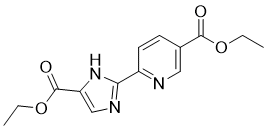This product is for research use only, not for human use. We do not sell to patients.

| Size | Price |
|---|---|
| 250mg | Get quote |
| 500mg | Get quote |
| 1g | Get quote |
Cat #: V3960 CAS #: 1821370-64-2 Purity ≥ 98%
Description: Diethyl pyimDC is a novel inhibitor of human CP4H1 (collagen prolyl 4-hydroxylase 1). Collagen is the most abundant protein in animals. Its overproduction is associated with fibrosis and cancer metastasis. The stability of collagen relies on post-translational modifications, the most prevalent being the hydroxylation of collagen strands by collagen prolyl 4-hydroxylases (CP4Hs). Catalysis by CP4Hs enlists an iron cofactor to convert proline residues to 4-hydroxyproline residues, which are essential for the conformational stability of mature collagen. Ethyl 3,4-dihydroxybenzoate (EDHB) is commonly used as a 'P4H' inhibitor in cells, but suffers from low potency, poor selectivity, and off-target effects that cause iron deficiency.
Publications Citing InvivoChem Products
Product Promise

- Physicochemical and Storage Information
- Protocol
- Related Biological Data
- Stock Solution Preparation
- Quality Control Documentation
| Molecular Weight (MW) | 289.29 |
|---|---|
| Molecular Formula | C14H15N3O4 |
| CAS No. | 1821370-64-2 |
| Storage | -20℃ for 3 years in powder form |
| -80℃ for 2 years in solvent | |
| Solubility In Vitro | DMSO: 10 mM |
| Water: N/A | |
| Ethanol: N/A | |
| SMILES Code | O=C(C1=CN=C(C2=NC=C(C(OCC)=O)N2)C=C1)OCC |
| Synonyms | Diethyl pyimDC |
| Solvent volume to be added | Mass (the weight of a compound) | |||
|---|---|---|---|---|
| Mother liquor concentration | 1mg | 5mg | 10mg | 20mg |
| 1mM | 3.4567 mL | 17.2837 mL | 34.5674 mL | 69.1348 mL |
| 5mM | 0.6913 mL | 3.4567 mL | 6.9135 mL | 13.8270 mL |
| 10mM | 0.3457 mL | 1.7284 mL | 3.4567 mL | 6.9135 mL |
| 20mM | 0.1728 mL | 0.8642 mL | 1.7284 mL | 3.4567 mL |
This equation is commonly abbreviated as: C1 V1 = C2 V2
- (1) Please be sure that the solution is clear before the addition of next solvent. Dissolution methods like vortex, ultrasound or warming and heat may be used to aid dissolving.
- (2) Be sure to add the solvent(s) in order.




































